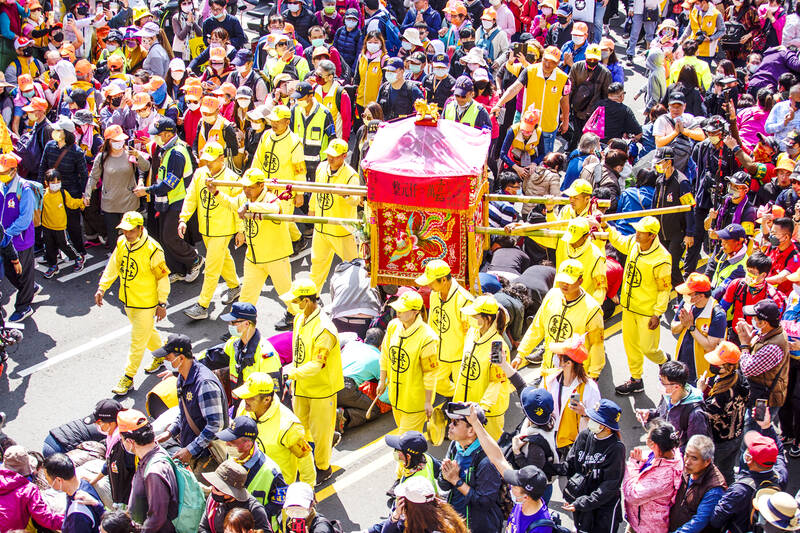The Matsu pilgrimage is one of Taiwan’s most iconic annual religious events. This grand occasion is more than just a religious ceremony; it deeply reflects Taiwan’s history and culture. Originally, Matsu was the goddess of the sea, primarily responsible for protecting fishermen and ensuring their safe voyage. As immigrants brought Matsu worship to Taiwan, she gradually evolved into a deity overseeing health, business, and various aspects of life. In times of uncertainty, Matsu has become a vital source of spiritual comfort for the Taiwanese.
The pilgrimage represents Matsu’s annual tour to inspect her domain, driving away evil and bringing peace to her followers. It is also a religious exchange among temples, which further strengthens the bond between the goddess and her followers. These activities not only signify divine interactions but also serve as a symbol of social unity. For the faithful who participate, these rituals hold deep personal meaning. Some join to fulfill a vow, thanking Matsu for past blessings, while others seek to purify their spirits through devout participation.
Matsu pilgrimages are held across Taiwan, each with its own unique characteristics. The Baishatun Matsu Pilgrimage is famous for covering about 340km on foot, testing both the endurance and faith of the participants. The Dajia Matsu Pilgrimage is renowned for its massive scale, while the Beigang Pilgrimage is known for its awe-inspiring atmosphere. In the offshore Penghu Islands, Matsu’s role in patrolling the sea perfectly reflects her origins as a protector of sailors.

Photo: Wikimedia / 照片:Wikimedia
In modern society, Matsu pilgrimages continue to attract participants from all walks of life, regardless of age, gender or social status. Through these rituals, people not only seek spiritual relief, but also help preserve cultural traditions and strengthen social bonds.
媽祖遶境是臺灣最具代表性的年度宗教盛事之一。這場盛大的活動不僅僅是宗教儀式,更深深地反映了臺灣的歷史與文化。最初,媽祖是海神,主要負責保護漁民和確保航海安全。隨著移民將媽祖信仰帶到臺灣,她逐漸演變成一位掌管健康、商業和生活各方面的神祇。在動盪不安的時代,媽祖成為臺灣人民重要的精神慰藉。
遶境象徵著媽祖每年巡視她的領域,驅逐邪惡並為信徒帶來平安。這也是寺廟之間的宗教交流,進一步鞏固了媽祖與信徒之間的聯繫。這些活動不僅象徵著神聖的互動,也象徵著社會的團結。對於參與的信徒們來說,這些儀式具有深刻的個人意義。有些人參加以履行誓言,感謝媽祖過去的庇佑;而有些人則希望透過虔誠的參與來淨化心靈。
媽祖遶境在臺灣各地舉行,每個地方都有其獨特的特色。白沙屯媽祖遶境以徒步約 340 公里聞名,考驗著參與者的耐力和信念。大甲媽祖遶境以其龐大的規模而聞名,而北港媽祖遶境則以其莊嚴的氛圍著稱。在離島的澎湖,媽祖巡視海域的角色完美地展現了她作為海員守護者的起源。
在現代社會,媽祖遶境持續吸引著來自各行各業的人們參加,不分年齡、性別或社會地位。透過這些儀式,人們不僅尋求精神上的慰藉,也幫助保存文化傳統並強化社會連結。
MORE INFORMATION
deity n. 神;女神
signify v. 表示;意味著
KEY VOCABULARY
1. pilgrimage n. 朝聖;進香
Many people make a pilgrimage to this sacred site each year to seek blessings and spiritual peace.
許多人每年都會前往這個神聖地點朝聖,以尋求祝福與心靈的平靜。
2. voyage n. 航行;航程
The maiden voyage of the ship was a great success, and every seat was taken.
這艘船的首航十分成功,所有的座位都坐滿了。
3. immigrant n.(外來的)移民
The city’s history is shaped by immigrants from around the world seeking better opportunities.
這座城市的歷史是由來自世界各地尋求更好機遇的移民所塑造的。
4. domain n. 領域;領地
The forest is considered the primary domain of many wild animals, providing them with shelter and food.
森林被視為許多野生動物的主要領地,為牠們提供庇護和食物。
5. divine adj. 神聖的
The religious man hoped his god would provide a divine sign to indicate what he should do.
這位虔誠的男子希望他的神明會提供一個神聖的跡象來指示他應該做什麼。
6. vow n. 誓言;誓約
The man made a vow that he would find his son’s murderer.
那位男子發誓他會找到殺害他兒子的兇手。
7. purify vt. 淨化;使純淨
The factory installed new filters to purify the water before releasing it into the river.
這間工廠安裝了新的過濾器來淨化水,然後才將水排入河中。
8. participation n. 參加;參與
participate vi. 參加;參與
participant n. 參加者;參與者
Active participation in class discussions can enhance your understanding of the subject.
積極參與課堂討論可以加深你對這門課題的理解。
9. awe-inspiring adj. 令人讚嘆的
The awe-inspiring view from the mountain summit took our breath away.
令人敬畏的山頂景色讓我們驚嘆不已。
學習音檔: https://magazine.english4u.net/Magdata/menu/t2oce
《空中美語》雜誌APP免費下載: https://www.english4u.net/apps/index.aspx
免費收聽當月《空中美語》雜誌課文朗讀及解析 !
文章由AMC空中美語授權使用: https://www.english4u.net

Historians are rethinking the way the Holocaust is being presented in museums as the world marks the 80th anniversary of the liberation of the last Nazi concentration camps this month. Shocking images of the mass killings of Jews were “used massively at the end of World War II to show the violence of the Nazis,” historian Tal Bruttmann, a specialist on the Holocaust, told AFP. But in doing so “we kind of lost sight of the fact that is not normal to show” such graphic scenes of mass murder, of people being humiliated and dehumanized, he said. Up to this

A ‘Dutch angle’ is a classic camera technique that has been used in filmmaking since the 1920s, when it was introduced to Hollywood by German Expressionists. Why is it called the Dutch angle if it’s actually German? In fact, it has no __1__ to the Netherlands. The term “Dutch” is widely believed to be a misinterpretation of “Deutsch,” which means German in the German language. In any event, the name stuck, and the Dutch angle remains a popular cinematic tool to this day. This technique involves tilting the camera on its x-axis, skewing the shot to create a sense of

When people listen to music today, they typically use streaming services like YouTube or Spotify. However, traditional formats like vinyl records have regained popularity in recent times. Vinyl records are circular discs that store music in grooves on their surfaces and are played on a turntable. As the turntable’s needle runs along these grooves, it picks up vibrations and translates them into sound. The history of vinyl records dates back to the late 1800s, but material and technological challenges delayed mass production until the 1950s. Despite early versions having short playtimes and poor sound quality, vinyl records introduced a new era

Dos & Don’ts — 想想看,這句話英語該怎麼說? 1. 能做的事都做了。 ˇ All that could be done has been done. χ All that could be done have been done. 註︰all 指事情或抽象概念時當作單數。例如: All is well that ends well. (結果好就是好。) All is over with him. (他已經沒希望了。) That’s all for today. (今天到此為止。) all 指人時應當作複數。例如: All of us are interested in his proposal. All of us are doing our best. 2. 我們這麼做有益於我們的健康。 ˇ What we are doing is good for our health. χ What we are doing are good for our health. 註︰以關係代名詞 what 引導的作為主詞的子句,動詞用單數。如: What he said is true. 3. 大家都沿著步道跑。 ˇ Everybody runs along the trail. χ Everybody run along the trail. 註︰everyone 是指一大群人,但在文法上一般用單數。 4. 桌上有一本筆記本和兩支筆。 ˇ There were two